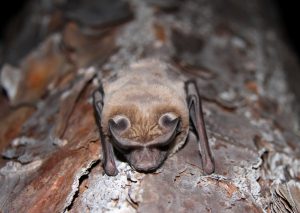By Holly Ober
UF/IFAS professor of wildlife ecology and conservation and Extension specialist; associate program leader for Natural Resources, UF/IFAS Extension

A group of researchers from the University of Florida and the Florida Fish and Wildlife Conservation Commission has been tracking endangered Florida bonneted bats for years.
Scientists, conducting their research in the Fred C. Babcock-Cecil M. Webb Wildlife Management Area of Charlotte County, marked nearly 350 of these bats with unique tags that provided information on the timing of when each individual entered and departed from their roosts — the structures where they sleep during the day.
After tracking bats for three years, they discovered that these bats differ from most other bats around the country in two ways.
First, unlike most temperate bats — which hibernate during winter — bonneted bats remain active year-round. Second, instead of living in large congregations, bonneted bats form small harem groups — about 15 individuals, with a male-to-female ratio of 1:3.
It appears as though a single, large male spends significant time at his roost structure, perhaps acting as a guardian.
This research highlights the importance of understanding wildlife social systems when developing conservation strategies and also highlights the crucial role of maintaining structures that could serve as roosts for these endangered bats — primarily pine trees, royal palm trees and bat houses.
 0
0
